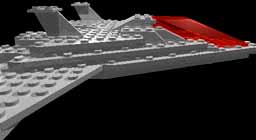|
02Build 1995, Pieces 120, Steps 9 |
Influence: At the time I made this model, I was strongly influenced by the classic gray and blue space series from the beginning of the '80ties. Basically I took the standard 4*8 wing and fiddled something together I thought looked good and moved on from there. |
Engines: The coincidental cut in the rear was a little surprise, but I decided to keep it (the model would look rather ordinary without it). Furthermore it gave the possibility to place the engine very central in the plane, thus making it possible to use the main engine as a semi-VTOL-system, by deflecting the jetstream downwards. (like the Harriers) |
Sculpting: What I disliked about Classic Space was the old-fashioned blue boxy part, since it didn't meet my demands of streamlinedness. The way I tried to avoid this was to sculpting a streamlined shape by using even more wings. The total amount of wings rose to 10 pairs and 2 doublewings with cutout. This huge waste of wings drained my supply enormous, (probably the reason why the next model became very small) and would be phased out in later models. |
Cockpit: When it comes to the cockpit I was only able to fit the pilot in in a lean back position (height of the cockpit is 10 plates) and thereby avoided adding even more layers to the model. |
More sculpting: The emphasis on the sculptural qualities meant that I refrained from making landinggear (and forgot to add flight controls!). You had to imagine it hidden in the hull. The engine was inspired by a new design at NASA at the time, where the jet stream was forced around a cone. I decided that it could just as well be separated in two on each side of the cut at the back of the plane. Proportion problems: Generally I dislike models that are broader than long, because I find that it make the model look slow. This model made me realize that, since it has the a extreme L/W-ratio of 1/1,36, and I've tried to avoid it in later models. However it gives problems with short models if you want to use the 4*8 wings since you can only reduce the width to a certain point. As a consequence about 1/3 of my models are broader than long, but since the wings are generally thin the problem is most visible directly from above. (or below) The few visitors that aren't asleep yet will argue that they cant see the problem, but that is due to the somewhat warped perspective in the computergenerated pictures. |
Inspiration: Although the shape came as a coincidence, there are signs that I've been somewhat inspired by the new spaceshuttle X33 NASA was working on at the time. The cut in the tail however (or rather use of it) was inspired by the evil general Olrik's plane "Red Arrow" from the classic Blake and Mortimer - cartoon "The fight for world supremacy" (my translation, "Le secret de l'espardon" by Edgar P. Jacobs" 1946-48) |
From this angle it have some resemblance with the
V-shaped "Red Arrow" |

 Copying models can't be
encouraged, basically you have to disassemble the whole model, and
then slowly assemble it again, whilst taking copies all along. The
process takes hours, and standing in light and ozone pollution is
wery tiring.
Copying models can't be
encouraged, basically you have to disassemble the whole model, and
then slowly assemble it again, whilst taking copies all along. The
process takes hours, and standing in light and ozone pollution is
wery tiring. The jetstream comes out from the slits inside the
cut.
The jetstream comes out from the slits inside the
cut. One plane with wings below and two on top of this
model nearly emptied the supply.
One plane with wings below and two on top of this
model nearly emptied the supply. Normally the cockpit needs to be at least 11 plates
high, here it's reduced to 10.
Normally the cockpit needs to be at least 11 plates
high, here it's reduced to 10. Without a landinggear the plane was left to land on
its belly.
Without a landinggear the plane was left to land on
its belly. The projected new spaceshuttle
X33 (now abandoned) had a triangular body.
The projected new spaceshuttle
X33 (now abandoned) had a triangular body.
